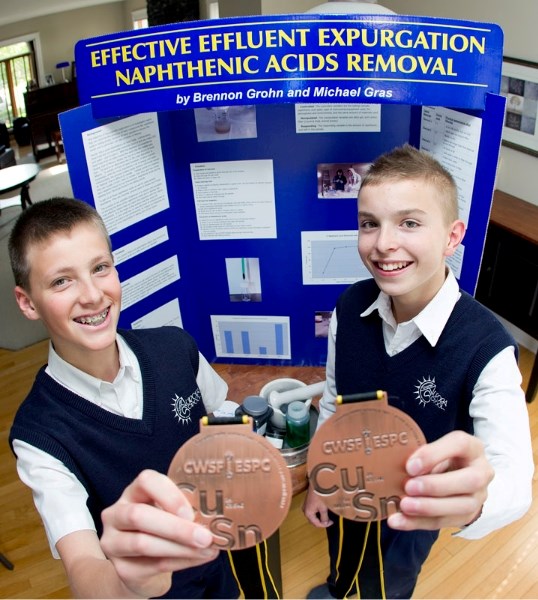A St. Albert student has won national fame for showing how a pet store product could help clean up oilsands tailings ponds.
Brennon Grohn of St. Albert and Michael Gras of Edmonton won bronze in the junior category at the Canada-Wide Science Fair earlier this month as well as $1,300 in scholarships. The event, held from May 14 to 21 in Toronto, saw 500 grade 7 to 12 students from across Canada competing for about $1 million in prizes.
Grohn and Gras, both 13, were two of the eight students from the Edmonton region at the fair, says Edmonton Regional Science Fair president Amanda Joblinski. All did extremely well, with Jaclynn Wong and Danny Huang of Edmonton winning best in the fair for their research into cancer treatment.
Grohn says this was his first time at nationals and that he got a huge kick out of meeting all the other students. "It was definitely one of the best experiences I've had so far."
Effective effluent expurgation
Grohn is a veteran of science fairs, he says, having attended his first in Grade 4 with a project on how people drown in grain bins. He teamed up with schoolmate Gras at Edmonton's Aurora Charter School two years ago.
The team decided to research oilsands tailings ponds after about 1,606 birds died on Syncrude's Aurora tailings pond on April 28, 2008. "It was a problem that had to be fixed," Grohn says, so they started brainstorming potential ideas. They did extensive research online, spoke to oilsands researchers, and visited the CanmetENERGY Technology Centre in Devon, which is known for tailings research.
"Tailings are the byproducts of the oilsands process," Grohn explains. Once companies remove the oil from the sand, they're left with a watery mix of sand, clay, lead and other toxins that are now stored in massive ponds.
Last year, Gras says, they researched what substance was best at removing organic matter from tailings pond water. The winner was sphagnum moss, especially when combined with magnetic stirrers. This year, they decided to focus on naphthenic acids — complex, corrosive substances that cause birth defects in animals.
The team took tailings water that contained 1,000 parts-per-million of naphthenic acid and ran it through pipettes packed with one of four commercial filter products used by industry. These products were compared to pipettes filled with activated charcoal bought from a local pet store sieved to various grain sizes. Once the water filtered through the pipettes — which took anywhere from 10 seconds to two days — the team measured the amount of acid left in the water with a colour-changing liquid (it turns more red when exposed to more acid).
The team found that activated charcoal could remove up to 98 per cent of the acid in their samples, while the best commercial filter managed just 68 per cent. "Charcoal worked much more effectively than all the other ones," Gras says.
Activated charcoal is a known adsorbent, Grohn says, and has much more surface area than other substances. This decreases the flow rate of the tailings, which gives the acid more time to be trapped in the filter.
"Activated charcoal isn't too expensive," he notes, "but in large amounts it would add up to a pretty hefty price."
He and Gras plan to see if they can make the charcoal reusable next year to reduce those costs.
Many science fair participants come back year after year, Joblinski says, and some stay on after high school as judges. Gary Kurek of Bonnyville won at nationals a few years ago, she notes, and now runs his own company based on the mobility aids he invented. "He's running his own company now at 19 years old."
Full results of the fair can be found at cwsf.youthscience.ca.




